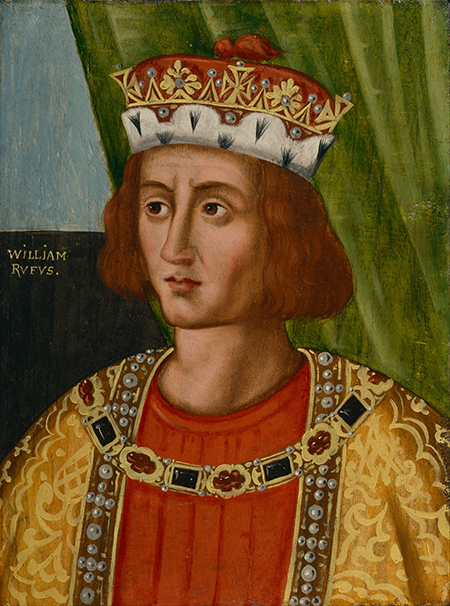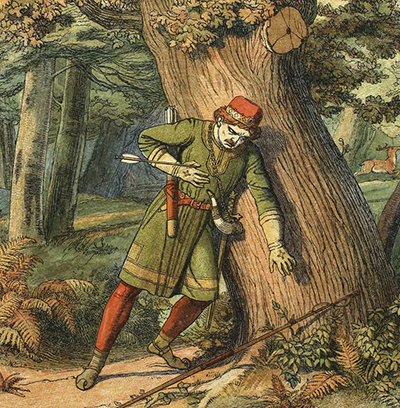



King William II Ė Quick Stats




Born: c. 1056 AD
William Rufus grew up in the midst of the Norman court, possibly receiving an education that was typical for a noble of his time. This would have included an emphasis on military training, governance, and a basic understanding of Christian doctrine. However, his early life remains somewhat obscure, and most of what we know about it comes from later chronicles and accounts. His relationship with his father seems to have been one of both favor and tension. William the Conqueror was a ruthless and ambitious king who maintained a tight grip on his empire, and while William Rufus undoubtedly benefited from this strong monarchy, his relationship with his father was fraught with friction, particularly over matters of succession.
William was determined to maintain control over Englandís wealth, both in terms of land and ecclesiastical holdings. One of the most significant aspects of his rule was his involvement in the affairs of the Church. William the Conqueror had exercised significant control over ecclesiastical appointments, ensuring that church leaders were loyal to the crown. William II continued this policy, which created ongoing tensions between the monarchy and the Church. One of the most famous episodes of this conflict was his relationship with Anselm, the Archbishop of Canterbury. Anselm, a pious and independent monk from Italy, clashed with William over issues of ecclesiastical reform.
The Life and Reign of King William II: A Complex Legacy
While William IIís reign was marked by significant conflict and internal strife, it also demonstrated his ambitions to establish a strong and centralized monarchy. Yet, his premature death, possibly at the hands of a conspirator, has ensured that his story remains a subject of intrigue and debate. In this article, we will dive deeper into the complexities of his life, reign, and the legacy that still echoes through English history.
Early Life and Background
William Rufus was born in 1056 as the second son of William the Conqueror and Matilda of Flanders. His birth, following the success of his fatherís conquest of England in 1066, placed him within a new Norman dynasty that was in the midst of reshaping the English social and political landscape.
William Rufus was born in 1056 as the second son of William the Conqueror and Matilda of Flanders. His birth, following the success of his fatherís conquest of England in 1066, placed him within a new Norman dynasty that was in the midst of reshaping the English social and political landscape.
Upon the death of William the Conqueror in 1087, the empire was divided among his sons. Robert, the eldest son, received the Duchy of Normandy, which was far more prestigious than the English throne. Meanwhile, William Rufus inherited the Kingdom of England. Though he had a strong claim to the throne, it came at the expense of his brother, Robert, who contested Williamís rule. This division of territories between the sons would set the stage for a tense and often fractious relationship, both between the brothers and within the broader context of European power struggles.
At the time of his fatherís death, William was 30 years old, a mature age for a monarch, yet still seen by some as less charismatic or capable than his father. He faced immediate threats to his rule from his elder brother Robert, who had long coveted the throne of England. Robert's failure to assert his claim to England in the immediate aftermath of William the Conquerorís death led to a prolonged struggle between the two brothers. While Robert spent much of his life involved in the Duchy of Normandy, often absent from England, William took advantage of this absence to strengthen his position in his new kingdom.
One of the first acts of Williamís reign was the consolidation of his authority, particularly in relation to the Anglo-Saxon nobility. The new king moved quickly to assert royal authority by using the legal framework his father had established, particularly through the Domesday Book, which was the record of all lands and their values within England. This system of governance ensured William the ability to tax and manage resources across his kingdom efficiently, but it also alienated many of the English nobility. Despite this, he succeeded in maintaining a stable monarchy throughout his reign, even if it was not marked by widespread admiration or reverence.
Reign and Key Policies
Williamís reign was defined by his military prowess, his administrative acumen, and his strained relations with the Church. Although his reign was relatively short, the political and military actions he took would shape the future of England.
Williamís reign was defined by his military prowess, his administrative acumen, and his strained relations with the Church. Although his reign was relatively short, the political and military actions he took would shape the future of England.

William II of England, known posthumously as William Rufus, is often a lesser-known figure in English history. Despite his reign lasting from 1087 to 1100, his legacy remains clouded by mystery, controversy, and his untimely death. As the second son of William the Conqueror,
Died: c. 2nd August 1100 AD
Mother: Matilda of Flanders
Father: William The Conqueror
Wife: None
Children: None
Successor: Henry I
Predecessor: Willaim the Conqueror
Ascension to the Throne
Williamís ascension to the English throne was a matter of convenience rather than inevitability. Although his fatherís death created a succession crisis, William was able to secure his position without major opposition, largely because he had the support of the English nobility. The Norman elite had already been accustomed to Williamís leadership, given his military experience and proximity to the throne, but his reign was not without challenges.
Williamís ascension to the English throne was a matter of convenience rather than inevitability. Although his fatherís death created a succession crisis, William was able to secure his position without major opposition, largely because he had the support of the English nobility. The Norman elite had already been accustomed to Williamís leadership, given his military experience and proximity to the throne, but his reign was not without challenges.
In 1093, Anselmís insistence on the independence of the Church from royal influence led to a standoff with William. In 1097, Anselm was exiled by the king, marking the peak of this power struggle. The monarchyís control over the Church in England remained a key issue throughout Williamís reign, and the tensions between the secular and religious authorities would continue to shape the course of English history.
In addition to his struggles with the Church, William focused on securing Englandís borders, particularly with Scotland and Wales. His military campaigns in the north were often directed against the Scottish King Malcolm III, whose raids on English territory threatened the stability of the kingdom. Williamís decisive action against the Scots ensured that English sovereignty was maintained in the northern regions. Similarly, William sought to expand Englandís influence over Wales, although his efforts to fully subdue the Welsh were ultimately unsuccessful.
The Domesday Book and Legal Reforms
The Domesday Book, commissioned by his father, continued to play an important role during Williamís reign. The book was essentially a comprehensive survey of land ownership and wealth across England, serving both as a tool for taxation and for military purposes. The meticulous documentation of the kingdomís resources enabled William to maintain tight control over his realmís wealth and manage the distribution of land and titles. While this administrative prowess may not have endeared William to his nobles, it allowed him to govern effectively and fund his military campaigns.
The Domesday Book, commissioned by his father, continued to play an important role during Williamís reign. The book was essentially a comprehensive survey of land ownership and wealth across England, serving both as a tool for taxation and for military purposes. The meticulous documentation of the kingdomís resources enabled William to maintain tight control over his realmís wealth and manage the distribution of land and titles. While this administrative prowess may not have endeared William to his nobles, it allowed him to govern effectively and fund his military campaigns.

Depiction of King William II Death
The Mystery of Williamís Death
William IIís sudden death on August 2, 1100, remains one of the most compelling mysteries in English history. He was struck by an arrow during a hunting expedition in the New Forest, and his death was initially declared an accident. However, many contemporaries and later historians have speculated that his death was the result of foul play.
William IIís sudden death on August 2, 1100, remains one of the most compelling mysteries in English history. He was struck by an arrow during a hunting expedition in the New Forest, and his death was initially declared an accident. However, many contemporaries and later historians have speculated that his death was the result of foul play.
Theories about Williamís death abound, with the most prominent theory being that his younger brother, Henry I, played a role in orchestrating his death. Henry quickly moved to claim the throne following Williamís death, an action that many saw as highly opportunistic. Although no concrete evidence has ever emerged to confirm the theory, the speed with which Henry took the throne and the absence of a clear heir to Williamís rule have led many to conclude that Henry was involved in his brotherís demise.
Williamís Legacy
William IIís legacy is complex. He was not the transformative figure his father was, nor was he as beloved or effective as his brother Henry I. However, his reign had significant consequences for the kingdom. He maintained a strong central authority, ensuring the monarchy's power in England despite the challenges of dealing with rebellious nobles, tensions with the Church, and external military threats. While he did not expand the borders of his kingdom or create any lasting institutions, he laid the groundwork for his brother Henryís reforms.
William IIís legacy is complex. He was not the transformative figure his father was, nor was he as beloved or effective as his brother Henry I. However, his reign had significant consequences for the kingdom. He maintained a strong central authority, ensuring the monarchy's power in England despite the challenges of dealing with rebellious nobles, tensions with the Church, and external military threats. While he did not expand the borders of his kingdom or create any lasting institutions, he laid the groundwork for his brother Henryís reforms.
The most lasting aspect of Williamís reign, however, is the mystery surrounding his death. His untimely end ensured that his reign would be remembered not for its accomplishments but for the shadow of suspicion that hung over it. Williamís death allowed Henry to assume the throne, beginning a new chapter in English history. While William II may not have had the long-lasting impact of other kings, his reign provides important insights into the early years of Norman rule in England, and his death serves as a poignant reminder of the intrigue, rivalry, and political maneuvering that characterized the medieval monarchy.
Conclusion
King William II's reign was brief, contentious, and ultimately overshadowed by the mystery of his death. Though he was not as beloved or influential as his father, William the Conqueror, or his brother, Henry I, his actions shaped the trajectory of the English monarchy. From his complex relationship with the Church to his military campaigns in Scotland and Wales, William's reign was a time of both consolidation and conflict. His legacy is ultimately defined by the unanswered questions surrounding his death, leaving a lasting mystery that has intrigued historians for centuries. Despite being a monarch marked by controversy, William II played a crucial role in the development of Norman England and its political landscape.
King William II's reign was brief, contentious, and ultimately overshadowed by the mystery of his death. Though he was not as beloved or influential as his father, William the Conqueror, or his brother, Henry I, his actions shaped the trajectory of the English monarchy. From his complex relationship with the Church to his military campaigns in Scotland and Wales, William's reign was a time of both consolidation and conflict. His legacy is ultimately defined by the unanswered questions surrounding his death, leaving a lasting mystery that has intrigued historians for centuries. Despite being a monarch marked by controversy, William II played a crucial role in the development of Norman England and its political landscape.
William Rufus inherited the throne of England under circumstances shaped by sibling rivalry, political maneuvers, and royal expectations. Although overshadowed by his more famous father and his even more accomplished younger brother, Henry I, William IIís reign holds critical importance in understanding the dynamics of early Norman England, particularly in relation to the monarchyís influence over the church, the nobility, and the borders of the realm.
Unlike his older brother, Robert Curthose, who was born before the Conquerorís marriage to Matilda and thus had a different position in the line of succession to Normandy, William grew up knowing that England would be his inheritance. His place in his fatherís empire was secured by his direct position as a royal son, yet the complex divisions of power between father and sons would prove a significant feature of his early life.


